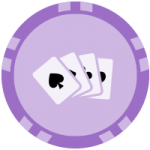Bet sizing is an important poker concept, as it contributes greatly to our overall profit. In the Part Two of this series, we analyse some bet sizing considerations in relation to perceived ranges of us and our opponents alike. Whether it is a bluff or value bet, proper sizing is of utmost importance for maximizing our gain.
- Our Perceived Range

- Implications of our Perceived Range on Sizing
- Villain's range
- Implications of Villan's range on Sizing
- The formula
- Levels and Balance
Our Perceived Range
In case you've missed Part 1 of this great series, you can find it here (Bet Sizing in Poker Part 1)If we really want to become masters of bet-sizing it's important for us to be able to analyse the strength of own perceived range - not just the strength of our opponents range.
Generally speaking the stronger our range is perceived to be the smaller we can get away with betting. We can bluff more cheaply when perceived to be strong, and we also will want to bet smaller to help our value-bets get paid off.
The idea of betting small with both our bluffs and our value-bets may seem counter-intuitive at first but is an important principle for when we begin to think about balancing our ranges. If we pick two different sizings for our value-bets and bluffs then our game will become readable if we are facing a decent opponent.
If it's not necessary to be balanced we shouldn't though and we can use different sizings depending on whether we are bluffing or value-betting. The sizings we pick should be smaller than average though when we are representing a strong range.
When we are perceived to be weak then it naturally follows that we should use larger sizings. Our opponent will be more inclined to call so we can counteract this by betting larger for value. If we want to bluff we will also need to make it larger to generate the required fold-equity. Again this may seem counter-intuitive and is to do with balance. Exploitatively we may be able to use different sizings for our value/bluff range - but on average these sizings will be larger than standard when our range is perceived to be weak.
Implications on Sizing
In order to

effectively use this concept it's important for us to first be able to recognize situations where we are perceived to be either weak or strong.
One great example of this is cbetting/betting in multi-way situations. Since we are betting vs multiple opponents, even without any history we are often perceived to be strong. The natural tendency in multi-way situation is for players to bet large because a) their bluff needs to get through multiple opponents and b) there are more players that can potentially call their value-bet.
In reality it's the opposite. Smaller than average bets are optimal here because a) we look very strong and can get a better risk/reward on our bluff and b) we want to encourage calls from worse hands since players may respond tighter when we are perceived to be strong.
The common situations where we are perceived to be weak occur primarily in late position and as a result of history. For example if we are cbetting very frequently over a reasonable sample then we are going to be perceived as weak. We can think about increasing our bet-sizing. We can also think about weighting our range towards value as an exploitative measure. (Often if perceived as weak it can be good idea to weight our range towards value while when perceived as strong weight towards bluffs. This particular concept is outside the scope of our discussion however).
Villain's Range
Whether this is more important than our own perceived range really depends on how decent our opponent is. If our opponent is a poor hand reader then we should primarily focus on his range rather than our own perceived range. If our opponent is strong and is aware of the range we represent than our perceived range can often become the most important factor. As a rough guide at stakes of 200nl+ we should be focusing heavily on our own perceived range while 100nl and below our opponent's range is likely more important.
The general premise is similar: if villain has a weak range we can get away with small sizings while if his range is strong we can use larger sizings. This should be treated as a rough guide only however.
Implications on Sizing
In order to

effectively use this concept we need to be able to identify situations in which our opponent is very weak. One of the most common situations is when our opponent checks as the preflop raiser. Most players cbet their best holdings and we may find that we can win the pot very frequently in these situations since our opponent has a capped range.
Or perhaps a situation where opponent passively calls down on a drawy texture where we know he would check-raise his premiums on an earlier street. We may have the nuts, but betting large could be a mistake.
Our perceived range for 3barreling is strong while our opponents range is weak. We should be able to conclude that a small bet-sizing with the nuts is much more effective than a large bet sizing. The natural inclination for many players is to size their bet based on the strength of their hand which is often a mistake.
The Formula
We can summarise everything that we have mentioned in the following rough guide.
- Our perceived rage weak + opponents range strong = large sizing
- Our perceived range strong + opponents range strong = average sizing
- Our perceived range weak + opponents range weak = average sizing
- Our perceived range strong + opponents range weak = small sizing
This should be taken as a starting point however and not a definitive guide to sizing in all situations. It's important we take into account our opponent's tendencies. He may have a weak range but simply not be folding that weak range to regular or small size bets. This is why we frequently would consider overbetting vs a range that is capped. Our fold-equity may drastically increase when compared to a regular sized bet.
Levels and Balance
In terms of game-theory principles the more bluffs we have in our range compared to value-hands the larger our sizing can be. For this reason it can be correct to bet very large in situations where we are representing an extremely narrow range.
EG 100bb effective stacks. BTN opens to 3bb. Hero calls in BB.
Flop is Kh2s2d. Hero checks. Villain checks.
Let's assume the average villain is cbetting all his Kx hands and better. If he's balanced he should theoretically check back a reasonable amount of made hands, but the average player doesn't do this meaning their turn range is very capped. We are looking primarily at holdings such as A-high and pocket-pairs.
Turn is the 3c
Opponent has a lot of decent bluffcatchers in his range at this point. It's not actually that likely he folds something like pocket tens to two regular size bets here. Let's also think of the value-range we are representing if we two barrel. It's extremely narrow. The occasional 2x hand, pocket threes, some Kx (although discounted because we may 3bet stuff like KQ/AK preflop).
Our range is frequently going to end up weighted towards bluffs here so it's logical for us to consider overbetting the turn and river. It makes it significantly harder for opponent to call down with any bluffcatchers and hence allows us to bluff more frequently in the long run. Exploitatively the main advantage to this line is simply that our opponent is capped and we can get him to fold the majority of his holdings.
However, let's for a minute think from our opponents point of view. If we really held something like KJo (perfectly legitimate) and we knew our opponents range is capped, would we really overbet two streets here for value? It doesn't make sense. We'd be more likely to bet regular sizings to encourage him to call with his bluffcatchers.
As a result, while mainly players are going to see the larger sizing and fold 100% of their range, a very strong opponent is going to realise we don't represent value very well with the overbet turn + river line and call with his bluffcatchers anyway; which can be catastrophic if we only have bluffs in our range.
This is exactly why we can think about overbetting turn and river for value here despite the dry texture. Whether we purely take this line as a bluff or choose to balance it with value combos really depends on our opponent. What we can categorically state though is since we representing a very narrow value range it can be correct to bet large from a game theory perspective.



